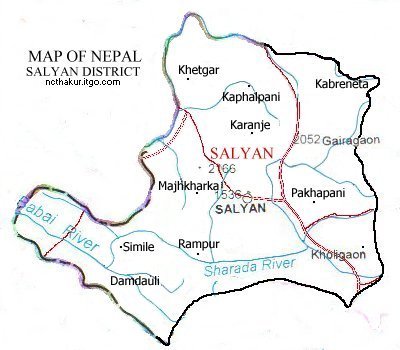Difference between revisions of "Water Portal / Rainwater Harvesting / Salyan and Dailekh, Nepal"
| Line 5: | Line 5: | ||
[http://www3.helvetas.ch/nepal/wEnglish/index.asp Helvetas SI Nepal] has developed and implemented a plan to address water management issues in a participatory and integrated manner. '''The Water Use Master Plan (WUMP)''' is a tool that puts the local community at the centre of decisions and that looks at water resources, water demands and potential uses in a broad and integrating way, including a prioritized list of water-related infrastructure plans. The tool has proved to be successful and is being replicated by a number of organisations in Nepal and has the interest of the government as well ([http://www.dolidar.gov.np/ DoLIDAR]). | [http://www3.helvetas.ch/nepal/wEnglish/index.asp Helvetas SI Nepal] has developed and implemented a plan to address water management issues in a participatory and integrated manner. '''The Water Use Master Plan (WUMP)''' is a tool that puts the local community at the centre of decisions and that looks at water resources, water demands and potential uses in a broad and integrating way, including a prioritized list of water-related infrastructure plans. The tool has proved to be successful and is being replicated by a number of organisations in Nepal and has the interest of the government as well ([http://www.dolidar.gov.np/ DoLIDAR]). | ||
| − | Although the experiences so far have been very positive, some challenges have been identified: WUMP should address water productivity in agriculture more prominently and should pay more attention to climate change effects. Through its collaboration with [http://www.rainfoundation.org/ RAIN], Helvetas SI Nepal | + | Although the experiences so far have been very positive, some challenges have been identified: WUMP should address water productivity in agriculture more prominently and should pay more attention to climate change effects. Through its collaboration with [http://www.rainfoundation.org/ RAIN], Helvetas SI Nepal is putting rainwater harvesting more to the forefront, and incorporating a catchment perspective with a 3R approach into the current WUMP module. |
| + | |||
| + | ====Cultural and socio-economic conditions==== | ||
| + | |||
| + | The 3R WUMP module will be piloted and tested in the field in two regions: Dailekh and Salyan, Mid Western Development Region of Nepal. | ||
| + | |||
| + | The project area in Salyan lies in the upper hills. Problems specific to these areas regarding water are the absence of pipe-line water supply, drying up of existing streams and springs, no potentials of bore well, and thereby high dependence on rainwater for drinking as well as agriculture. Dependence on in situ rain for agriculture limits the production of different agricultural products that require less water in the drier seasons and thus increases food insecurity. The degree of vulnerability is higher amongst the poorer section of the population. | ||
| + | |||
| + | The proposed area in Dailekh is the area with the highest water hardship: it lacks drinking water and has poor hygiene and sanitation. The existing sources of water supply are spring sources located away from the village and with very low discharge. About six hours per day during the dry season and five hours per day during the rainy season needs to be invested to manage their water. Gravity-driven water supply is not possible in the area. The overall socioeconomic status of the households is a disadvantaged group, i.e. socially discriminated and economically poor. | ||
Revision as of 01:37, 25 April 2013

The current water supply and food security
Helvetas SI Nepal has developed and implemented a plan to address water management issues in a participatory and integrated manner. The Water Use Master Plan (WUMP) is a tool that puts the local community at the centre of decisions and that looks at water resources, water demands and potential uses in a broad and integrating way, including a prioritized list of water-related infrastructure plans. The tool has proved to be successful and is being replicated by a number of organisations in Nepal and has the interest of the government as well (DoLIDAR).
Although the experiences so far have been very positive, some challenges have been identified: WUMP should address water productivity in agriculture more prominently and should pay more attention to climate change effects. Through its collaboration with RAIN, Helvetas SI Nepal is putting rainwater harvesting more to the forefront, and incorporating a catchment perspective with a 3R approach into the current WUMP module.
Cultural and socio-economic conditions
The 3R WUMP module will be piloted and tested in the field in two regions: Dailekh and Salyan, Mid Western Development Region of Nepal.
The project area in Salyan lies in the upper hills. Problems specific to these areas regarding water are the absence of pipe-line water supply, drying up of existing streams and springs, no potentials of bore well, and thereby high dependence on rainwater for drinking as well as agriculture. Dependence on in situ rain for agriculture limits the production of different agricultural products that require less water in the drier seasons and thus increases food insecurity. The degree of vulnerability is higher amongst the poorer section of the population.
The proposed area in Dailekh is the area with the highest water hardship: it lacks drinking water and has poor hygiene and sanitation. The existing sources of water supply are spring sources located away from the village and with very low discharge. About six hours per day during the dry season and five hours per day during the rainy season needs to be invested to manage their water. Gravity-driven water supply is not possible in the area. The overall socioeconomic status of the households is a disadvantaged group, i.e. socially discriminated and economically poor.
